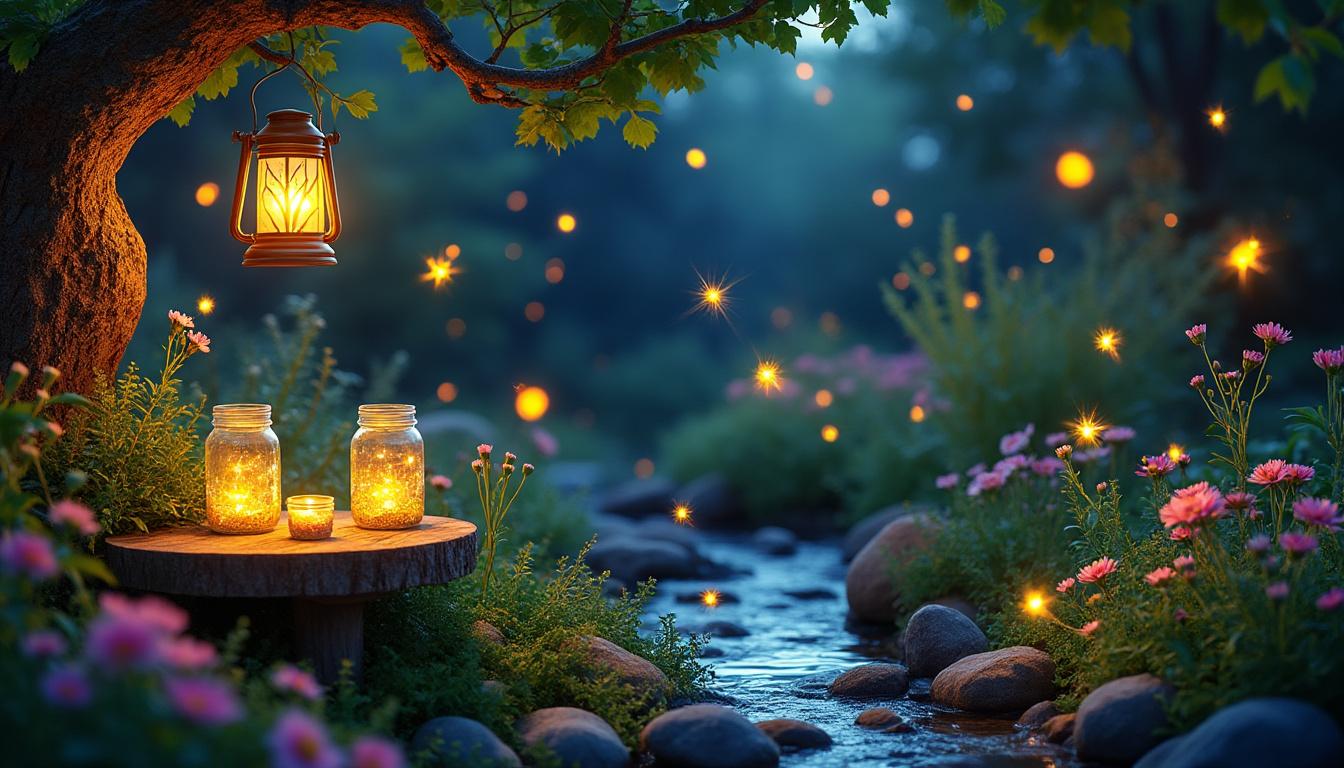Fireflies have long been emblematic of warm summer nights, casting their gentle, rhythmical glow across gardens and yards, creating scenes straight out of a fairy tale. Their faint pulses of light, a natural spectacle of bioluminescence, have inspired countless moments of awe and contemplation. Yet, the magic of these enchanting nightlights often eludes urban and suburban gardens due to environmental changes, artificial lighting, and landscaping choices. Transforming a simple patch of outdoor space into a nocturnal paradise filled with whimsical yard lights and nature’s sparkle requires intentional effort but promises captivating results. By adopting strategic adjustments, gardeners can cultivate firefly gardens that come alive at twilight, turning their outdoor zones into serene firefly sanctuaries and magical lightscapes to admire night after night. This guide explores four proven and enchanting methods to invite these glowing marvels, enriching your nighttime oasis with soft, glowing decor that harmonizes with local ecosystems.
Reducing Artificial Light Pollution to Foster a Firefly-Friendly Twilight Glow
Understanding the detrimental impact of artificial lighting on fireflies is essential to successfully attracting these natural luminaries. Fireflies rely on their bioluminescent signals for mating and communication, making dim, natural environments critical for their survival and activity. Bright outdoor lights, including excessive porch lights, landscape floodlights, and motion-activated lamps, create glare that overwhelms and confuses fireflies. Such luminance disrupts their ability to see each other’s mating flashes, effectively silencing the magical flickering spectacle that defines garden luminaries.
Expert insights from professionals like Ed Dolshun, a specialist in habitat-friendly pest control, emphasize that “artificial lights interfere with firefly mating flashes, so the darker your yard is, the better your chances of seeing fireflies light up within it.” Transitioning to lower intensity lighting, such as amber-hued bulbs or shielded lanterns, can retain nighttime visibility while preserving the fireflies’ tranquil environment.
Practical steps gardeners can take include:
- Turning off unnecessary outdoor lights during dusk and nighttime hours.
- Replacing bright white bulbs with amber or warm-toned torch lights that emit less disruptive light waves.
- Using motion sensors with timers to limit illumination periods strictly.
- Installing physical light shields or using directional fixtures to minimize spillage into critical firefly zones.
- Creating dark zones within the garden where fireflies can safely display their enchanting nightlights.
| Lighting Approach | Effect on Fireflies | Energy Efficiency | Suitability for Firefly Gardens |
|---|---|---|---|
| Bright White Floodlights | Highly disruptive; inhibits bioluminescent signals | Moderate | Poor |
| Amber Glass Wall Sconces | Minimally disruptive; helps retain twilight glow | High | Excellent |
| Motion-Activated Timers | Partially disruptive; reduces light duration | High | Good with proper timing |
| Shielded Directional Fixtures | Low disruption; controls light spread | High | Very Good |
Adopting such strategies will establish an optimal ambiance for fireflies, enhancing your chances of witnessing their serene firefly dances. For garden enthusiasts eager to learn more about creating such low-light sanctuaries, resources such as Daily Bakersfield News offer further expert advice and practical tips.
Eliminating Pesticides to Promote Firefly Population in Your Garden Luminaries
Fireflies thrive in environments where soil and plant health remain organic and pesticide-free. The larvae of fireflies develop underground or within moist garden debris; thus, the application of chemical sprays and broad-spectrum pesticides proves devastating. These substances not only diminish mosquito populations but also inadvertently annihilate beneficial insects, including firefly larvae, reducing the natural glow of your garden luminaries drastically.
Bryan Clayton, CEO of GreenPal, recounts his experience assisting gardeners to revive firefly-rich environments through conscientious pesticide management. “Switching from chemical sprays to natural repellents allowed the local ecosystem to balance itself,” he explains. This measure enables the entire food chain, including insects that serve as prey for fireflies, to flourish, creating a more vibrant nighttime oasis.
To encourage this enchanting transformation, gardeners should consider:
- Eliminating all synthetic pesticide and herbicide use.
- Adopting natural pest control methods such as neem oil, insecticidal soaps, or introducing beneficial predators like ladybugs.
- Maintaining organic garden beds with mulch made from natural materials.
- Encouraging biodiversity to establish a robust and interconnected garden ecosystem.
- Monitoring garden health regularly to manage issues before they require harsh interventions.
These sustainable gardening practices promote the delicate balance needed for fireflies to thrive. Importantly, they reinforce the garden’s role as a nighttime oasis, where magical lightscapes naturally emerge. Furthermore, gardeners interested in eco-friendly landscaping will find ample guidance from professional landscaping forums and credible information portals like Daily Bakersfield News.
Designing Layered Plant Structures to Create Vibrant Firefly Gardens
Crafting a diverse planting palette that integrates multiple vertical layers generates an ideal habitat for fireflies. Unlike manicured lawns, which lack complexity, layered gardens mimic a natural forest edge, providing fireflies with ample shelter, breeding grounds, and resting locales. Trees create canopy and shade, shrubs occupy mid-level spaces, while ground cover offers protection and hunting territory at the base.
Nicole Carpenter, president of Black Pest Prevention, champions this landscaping approach. She highlights how wild, uneven garden margins serve as firefly enclaves: “The more vertical variety, the better. Fireflies love messy margins and layered habitats where grass, shrubs, and low trees merge.” This principle favors plant diversity, yielding greater ecosystem resilience and a more immersive glow in the dark decor.
Recommended plants and structural additions include:
- Canopy Trees: Pumillio Mugho Pine (6-10ft) – provides shade and egg-laying sites.
- Shrubs and Medium Plants: Cherry-Go-Round Hydrangea (2 Gallon) – offers lower-level blooms and shelter.
- Grasses & Ground Covers: Ornamental grasses with soft hues (3-4ft) – safe zones for fireflies to navigate.
- Mossy Logs and Fallen Branches: Natural features that increase habitat complexity.
- Trellises and Raised Beds: Structures like the Panacea steel a-frame trellis and wooden raised garden beds to add vertical layers.
| Plant Type | Height Range | Purpose in Firefly Habitat |
|---|---|---|
| Pumillio Mugho Pine | 6-10 feet | Shade provision, egg-laying habitat |
| Cherry-Go-Round Hydrangea | 2-3 feet | Lower blooms for cover and nectar source |
| Ornamental Grasses | 3-4 feet | Safe ground-level movement and shelter |
Adopting such non-uniform planting designs transforms the yard into a vibrant, whimsical yard lights haven, encouraging fireflies to inhabit multiple layers and contributing to a dynamic, shimmering nightly spectacle.
Creating Dedicated Firefly Zones to Support Nature’s Sparkle in Your Garden
Designating a portion of the garden as a specialized firefly haven honors the natural behaviors and habitat requirements of these nocturnal insects. Such zones embrace untamed or semi-wild features—retaining leaf litter, woody debris, and patches of longer grass—to foster ideal breeding and hiding spots for fireflies.
Landscape expert Bryan Clayton advocates for embracing wild corners, “Leaving leaves and woody debris in some garden areas creates cradles where fireflies can thrive.” This low-maintenance area enriches biodiversity and sustains the magical lightscapes intrinsic to an authentic firefly garden. Contrary to the manicured appearance many seek, these habitats invite a gentle chaos that nurtures fireflies effectively.
Key elements for establishing a firefly zone include:
- Deliberately leaving some yard segments less manicured with natural debris.
- Incorporating native ferns and grasses that provide shelter during daytime.
- Using garden fences or trellises such as decorative modular fences that define but do not isolate firefly areas.
- Encouraging climbing plants on these fences to further integrate the zone with the garden’s ecosystem.
- Reducing foot traffic and disturbance in the designated area to allow fireflies undisturbed activity.
| Firefly Zone Features | Ecological Benefits | Design Tips |
|---|---|---|
| Leaf Litter & Woody Debris | Egg laying & larval development habitat | Leave undisturbed corners |
| Native Ferns & Grasses | Daytime shelter & moisture retention | Plant in semi-shaded zones |
| Decorative Modular Garden Fencing | Zone definition & climbing plant support | Choose adaptable panels for flexibility |
By integrating these principles, your garden can evolve into a nighttime oasis embodying nature’s sparkle and engaging all senses. Fireflies will not only visit but establish local populations, illuminating your yard with their enchanting nightlights year after year.
Frequently Asked Questions About Crafting a Magical Firefly Garden
- What kind of lighting is best to attract fireflies?
Low-intensity warm yellow or amber lighting is ideal. Avoid bright white or blue-toned bulbs that interfere with fireflies’ bioluminescent communication. - Can I use any plants to attract fireflies?
Plants that create layered habitats such as trees, shrubs, and ornamental grasses are beneficial. Native plants that offer moist soil and cover are especially attractive to fireflies. - How important is pesticide avoidance in attracting fireflies?
It is crucial. Many pesticides kill firefly larvae and disrupt their food sources. Avoiding chemicals supports a healthy ecosystem and encourages firefly presence. - Does having a water feature help attract fireflies?
Yes, small water features like birdbaths or ponds provide moist microhabitats ideal for firefly life cycles but should be mosquito-controlled naturally to avoid pest issues. - How long does it take to see fireflies after making garden improvements?
It typically takes one to two seasons for fireflies to return and establish if the environment becomes suitable and undisturbed, though this can vary based on location and climate.

